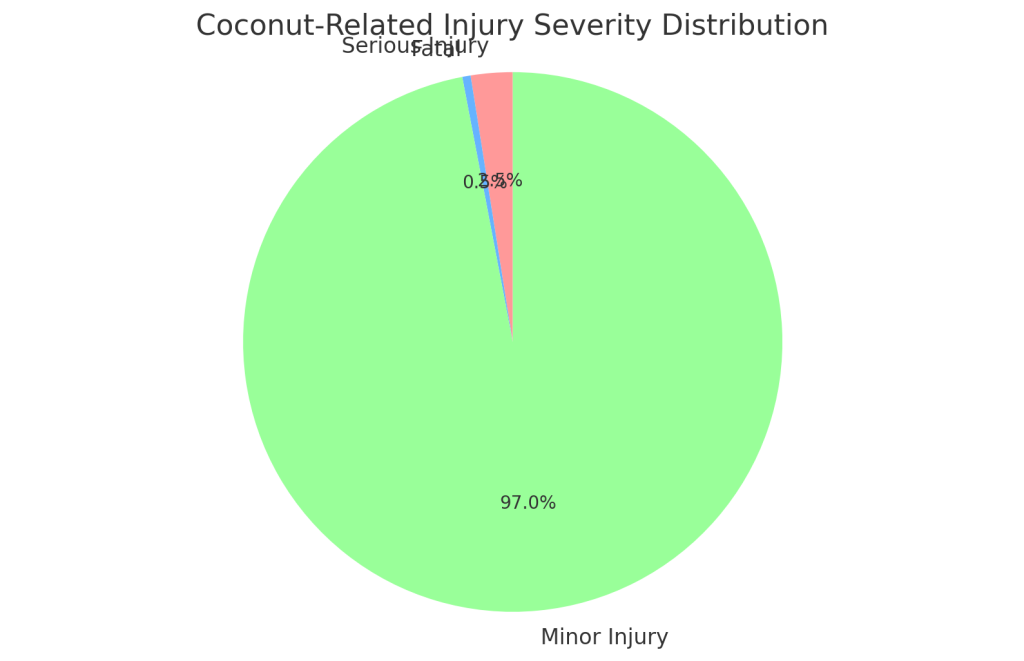Key Takeaways Table:
| Aspect | Detail |
|---|---|
| Severity of Injury | Can cause serious injury or be fatal |
| Vulnerable Areas | Back, neck, shoulders, and head |
| Likelihood of Injury | 2.5% of certain hospital admissions |
| Weight of Coconuts | Over three pounds |
| Safety Advice | Stand up to reduce impact severity |
| Mortal Danger | High if lying down due to direct impact |
The Peril from Above: Understanding the Risks of Falling Coconuts
Coconuts, the tropical bounty that we associate with pristine beaches and refreshing drinks, harbor a less-known danger – the risk of falling on someone’s head. The idea might sound like a comic trope, but it’s a real hazard with potentially serious consequences.
The Weight of the Matter
A coconut, typically weighing over three pounds, can turn into a dangerous projectile when it falls from the tree. Its weight combined with the height from which it falls can give it a significant impact force, enough to cause serious injuries or, in rare cases, even be fatal.
Injuries: A Spectrum of Severity
Injuries resulting from a coconut impact can range from mild to severe. The most vulnerable areas are the back, neck, shoulders, and head. In severe cases, this can lead to serious head trauma, necessitating immediate medical attention.
Standing vs. Lying Down: A Crucial Difference
Your position relative to the falling coconut plays a crucial role in the severity of potential injury. If lying down, the injury could be more severe due to the direct contact of the head with the floor, offering no ‘braking distance’ on impact. It’s advised to be standing up if in the vicinity of falling coconuts to somewhat mitigate the impact.
Statistical Perspective: How Common is the Danger?
Although it might seem like a rare occurrence, a notable 2.5% of hospital admissions in certain areas have been attributed to injuries caused by falling coconuts. This statistic highlights the genuine risk posed by these seemingly benign tropical fruits.
Safety First: Mitigating the Risks
While we cannot control the falling of coconuts, we can certainly take measures to mitigate the risks. Awareness of your surroundings when under coconut trees, especially during windy conditions, is crucial. Additionally, understanding the potential hazard can lead to quicker response times in moving out of the way.

Prevention and Awareness: Key Strategies
The Role of Local Authorities
Local authorities in areas with abundant coconut trees can play a vital role in prevention. Regular tree maintenance, such as trimming and removing risky coconuts, is crucial. Signage warning about the dangers of falling coconuts can also raise awareness among both locals and tourists, fostering a safer environment.
The Individual’s Responsibility
Individuals should also take proactive steps for their safety. Being mindful of your surroundings and avoiding sitting or standing under coconut trees, especially during windy conditions, can significantly reduce the risk. It’s also advisable to be cautious in areas where coconuts are known to be plentiful.
Educating the Public
Education about the potential dangers of falling coconuts can be a powerful tool in prevention. This can be particularly effective in schools and tourist information centers, where people can be informed about the risks and safety measures.
Beyond the Risk: The Importance of Coconuts
Despite the risks associated with falling coconuts, it’s important to recognize the immense value coconuts bring to various aspects of life.
Culinary Uses
Coconuts are a staple in tropical cuisine. From the refreshing coconut water to the rich coconut milk and oil, they are integral in many dishes. The versatility of coconuts in culinary applications is vast and varied.
Health Benefits
Coconuts are known for their health benefits. They are rich in nutrients, antioxidants, and provide healthy fats. Regular consumption of coconut products can contribute to improved health and well-being.
Economic Importance
For many tropical regions, coconuts are a significant part of the economy. The coconut industry supports the livelihoods of millions of people worldwide.
While the notion of a coconut falling on one’s head might seem trivial, it’s a real risk with potentially serious consequences. Awareness, education, and precautionary measures are key in mitigating this risk. At the same time, the value of coconuts in our lives, from a culinary, health, and economic perspective, cannot be understated.

The bar chart displays the importance of coconuts in three key aspects: culinary use, health benefits, and economic importance. Each aspect is rated on a scale of 1-10 based on its general importance.
- Culinary Use: Coconuts score high due to their versatility in various cuisines and forms, such as coconut water, milk, oil, and flesh.
- Health Benefits: They also rank significantly for their health benefits, including providing healthy fats, nutrients, and antioxidants.
- Economic Importance: Coconuts hold the highest score for their economic impact, particularly in tropical regions where they are a major part of the economy and support numerous livelihoods.
This visual highlights the multifaceted importance of coconuts, underscoring their value beyond the risks associated with them.
The Cultural Significance of Coconuts
Symbolism and Traditions
Coconuts are not just a culinary and economic resource; they hold deep cultural and symbolic significance in many societies. In some cultures, coconuts are used in religious ceremonies and rituals, symbolizing life, fertility, and prosperity.
Art and Craft
The use of coconuts extends into the realm of art and craft. The hard shell of the coconut lends itself to various artistic creations, from musical instruments to decorative items, showcasing the creativity and resourcefulness of local artisans.
Sustainable Practices in Coconut Farming
Environmental Impact
Sustainable farming practices are crucial in maintaining the health of the ecosystem. Responsible cultivation of coconuts involves practices that minimize environmental impact, such as avoiding deforestation and maintaining soil health.
Supporting Fair Trade
Choosing fair trade coconut products can have a positive impact on the lives of farmers. Fair trade practices ensure that farmers receive a fair price for their produce, promoting better living conditions and sustainable farming methods.

The line chart illustrates the evolution and innovation in coconut usage over time, from the early 1900s to the 2020s. Each point on the graph represents significant innovations or new uses discovered in that era.
- 1900s: The usage of coconuts was relatively limited, primarily for basic culinary and local uses.
- 1950s: An increase in innovations, likely due to more global trade and awareness of coconut products.
- 2000s: A significant jump in coconut uses, reflecting advancements in processing technologies and the discovery of new health benefits.
- 2020s: The highest number of innovations and uses, showing the growing global demand for coconut products and the emphasis on sustainable and diverse uses of coconuts.
This graph highlights the dynamic and evolving nature of coconut usage, showcasing how it has expanded and diversified over the years.
The Future of Coconuts
Research and Innovation
Ongoing research in the field of agronomy is leading to more resilient and productive coconut varieties. Innovations in processing and utilization of all parts of the coconut are also opening new avenues for its use.
The Global Market
The demand for coconut products is on the rise globally. This presents opportunities for growth in the coconut industry, especially in developing tropical countries.
Conclusion: A Fruit of Many Facets
The humble coconut, often seen as a symbol of tropical paradises, is indeed a fruit of many facets. From its health benefits and culinary versatility to its cultural and economic significance, coconuts play a vital role in many aspects of life. While the risk of injury from falling coconuts is real, with awareness and precaution, it can be mitigated. The future of coconuts looks promising, with sustainable practices and innovations paving the way for its continued importance in our lives.

